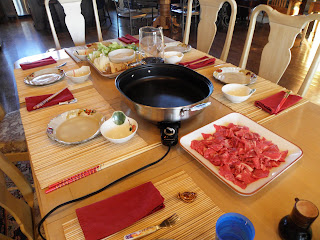
Sukiyaki Ingredients
Ingredients
 Table is ready
Table is ready
 Time to eat!
Time to eat!
 Ingredients
Ingredients Table is ready
Table is ready Time to eat!
Time to eat!My son John David, his wife Lauren, and our granddaughter Kyndal were coming to visit on Sunday and he requested our family sukiyaki dinner. My mother always prepared this dinner on special occasions and for company and I always have fond memories of her standing over the skillet with her chopsticks, making sure everyone gets their desired items before she ever tasted a single bit. He said he wanted me to teach him how to make it so he could prepare it for his own family and friends.
Sukiyaki is a Japanese "hot-pot" dish prepared at the table. It contains thin slices of beef, vegetables, noodles, and tofu in a special broth and is eaten with rice. The traditional way of eating sukiyaki is to dip the hot items in raw egg to cool them, but I've found many people are squeamish about this practice. I found a pasteurized egg product that can be used instead, but I personally still use a beaten raw egg sprinkled with togarashi (hot pepper).
Most of the preparation is done in advance and the sukiyaki is prepared in front of the diners.
On a cold evening the steaming skillet of meat and vegetables is so appetizing. Here's the family recipe:
1 1/2 pounds thinly sliced beef (I prefer rib-eye steak, frozen and sliced very thin.) (Sukiyaki can also be made with chicken or skip the meat altogether.)
1 tsp vegetable oil
1 bunch of scallions, cut into 2 inch lengths
1 white onion, sliced
1 block medium firm tofu, cut into bite size squares
12 oz shirataki (yam noodles, rinsed, drained, briefly boiled in water, drained again)
1 cup bamboo shoots, sliced
8 shiitake mushrooms, sliced 1/4 inch thick
2 cups udon noodles, cooked in advance (or packaged type which are already cooked)
4 cups napa cabbage, cut into large pieces
Sauce:
1/2 cup soy sauce (ok to use low sodium)
1/2 cup sugar (ok to reduce a little)
2 T sake
1 cup water
Mix together and put in pitcher or glass container for the table.
Arrange all ingredients on attractive platters. I put the meat on a separate dish and put noodles in their own bowls. Make sure everyone has a bowl of hot white Japanese rice and a bowl of beaten egg. (Also, try poaching your egg in the broth if the raw egg is a turn off.)
Heat the skillet an add a teaspoon of oil. Saute the beef until lightly browned and move to one side of the skillet. Add a few of each of the other ingredients, except the udon noodles. Add sauce to barely cover the ingredients. Cook until the vegetables are done, but this will only take a few minutes. Do not overcook. Serve each diner a taste of each item until pan is empty. You can ladle sauce on their rice if you like (but don't do that in front of Japanese people--it's not cool.) Add more of the ingredients to the skillet and cook again. Toward the end, start cooking the udon noodles. They seem to soak up a lot of broth so I always cook them last.
Leftover sukiyaki on top of rice is delicious as well.
I hope John David makes sukiyaki in the future and thinks of his grandmother and mother.
 RSS Feed
RSS Feed Twitter
Twitter


 9:21 AM
9:21 AM
 Unknown
Unknown











1 comments:
Hi Julia ~ Thank you for coming by my site. I find myself smiling as I read some of your blog posts. My grandmother was a great cook who expressed her love and individuality with food. And whenever I eat or cook familiar dishes, I always think of her and her warmth. It's lovely to see that being passed down from generation to generation. Have a lovely rest of the weekend.
Post a Comment